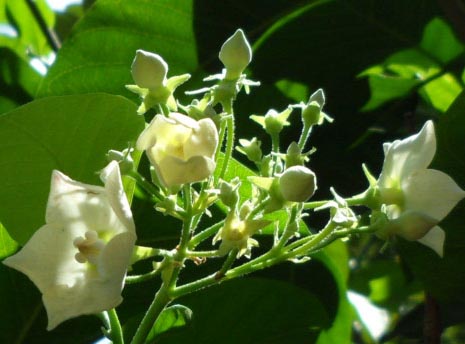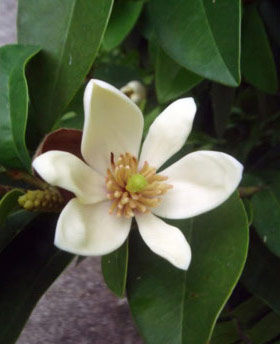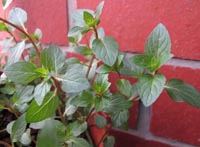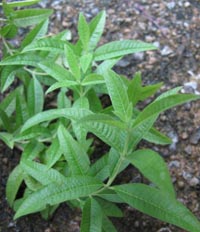Trick Or Treat? Plants With Unexpected Scents
A garden engages most if not all of the five senses – and scent is a very important one. In an ornamental garden, we enjoy and often associate certain floral scents with specific flowers. In herb gardens, we can identify a herb just taking a sniff at it.
To delight and even confuse visitors to your garden, try growing some of the plants featured here. These are mimics which smell convincingly like other flowers, herbs and even food. They will intrigue your sense of smell and are also fun ways to introduce children to the wonders of the Plant Kingdom!
As a simple experiment, pluck the flowers or leaves responsible for the scent from the plant, and place them into an opaque box with a small hole in its lid. Let your friends sniff the unseen contents, and ask them to guess what’s inside the box. Surprise them when you open the box and reveal the plants within.
| Bread Flower
The bread flower plant (Vallaris glabra) is best known for its clusters of white, star-shaped flowers. The flowers give off a smell that is reminiscent of pandan leaves or cooked fragrant jasmine rice. Once established, the plant is relatively free-flowering and rather drought-tolerant. It is a perennial, woody vine that is best grown over a pergola or strong trellis. A sun-lover, it prefers to grow in an outdoor location with full sun exposure. The soil should be fertile and well-draining. This plant is propagated via air-layering. You can enjoy the bread flower’s scent by placing a cut spray in your car or on your desk as a natural air freshener. Avoid touching the milky sap that oozes from the cut end; you can stop the flow of sap by putting it in water. |
 |
| Banana Shrub
As its common name suggests, the banana shrub (Magnolia figo) produces flowers with a distinctive, sweet banana scent. It is one of the more rewarding species of Magnolia to grow in the tropics. It is a compact-growing plant and can be used to plant up a fragrant hedge in the garden. The banana shrub prefers to grow in a sunny location outdoors that is well-draining, with fertile soil that is rich organic matter. Not particularly fast-growing, it is a low-maintenance shrub that does not need to be frequently pruned. It can be propagated easily from stem-cuttings. |
 |
| Garlic Vine
The leaves of the aptly-named garlic vine (Mansoa hymenaea) emit a garlicky smell when crushed. The plant is a perennial, woody climber. Like the bread flower, the garlic vine is best grown over a pergola or strong trellis. This attractive plant is not a constant bloomer in Singapore, but when it does, the flowering is profuse. The flowers are trumpet-shaped and produced in dense clusters. Each blossom starts off purple, then changes to a lighter shade of lavender with age and finally fades to white. At any one time, you can see three different floral colours on the plant. This plant prefers to receive direct sunshine for most of the day. It grows best in well-draining soil that is mulched at the base with compost to keep the roots cool and moist. Semi-hardwood cuttings can be taken for propagation. |
 |
| Chocolate Mint
Chocolate mint (Mentha x piperita f. citrata 'Chocolate') is one of the many cultivars of the peppermint. It features pointed, toothed leaves that take on a purplish cast when grown in good light. Its leaves emit a scent that is reminiscent of a mint chocolate slice. Like the leaves of many other mints, those of the Chocolate Mint can be dried and added to tea, or used on their own to infuse mint tea. They also make a nice addition to chocolate-flavoured desserts. Chocolate mint is best grown in a location where it is exposed to morning sunlight only. It should be potted in fertile and well-draining soil that is kept moist at all times. This plant is easily propagated via stem-cuttings. While it is not commonly available in local nurseries, chocolate mint is occasionally available for sale at HortPark’s quarterly gardening bazaar. |
 |
| Lemon Verbena
The lemon verbena (Aloysia triphylla) is an unusual herb with highly fragrant lemon-scented leaves. It grows as a scraggy shrub, and needs to be propped up and pruned to keep it looking tidy. It occasionally produces delicate small white flowers. The leaves of the lemon verbena have numerous uses. They can add a lemony flavour to fish and poultry dishes, as well as jams, puddings and beverages like herbal teas. Lemon verbena is best grown in a location where it receives morning sunlight. It can be potted in well-draining soil. Propagation is done via stem-cuttings, but can be tricky. This plant is not commonly available in local nurseries, but is occasionally available for sale in HortPark’s quarterly gardening bazaar. |
 |
By Wilson Wong
Have views or comments on this article? Let us know via this form. If you would like to give us feedback on any other areas relating to our parks and gardens, please submit via https://www.nparks.gov.sg/feedback



Li-San 6/23/2015 8:33:14 AM